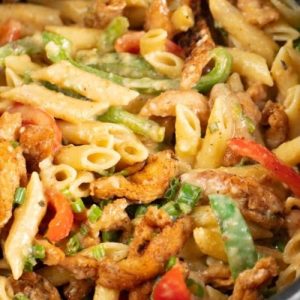This vibrant Vegan Rasta Pasta combines bold Caribbean flavors with creamy, satisfying pasta, making it a wholesome plant-based meal.
Packed with protein-rich soy curls or tofu, fiber-loaded vegetables, and heart-healthy coconut milk, it’s naturally low in saturated fat.
Quick to prepare and perfect for weeknight dinners or meal prep, it’s a colorful, nourishing, and comforting dish everyone will love.

30-Minute Vegan Rasta Pasta
Equipment
- 1 Large Nonstick Pot or Deep Skillet
- 1 cutting board
- 1 sharp knife
- 1 measuring cup
- 1 measuring spoon
- 1 Wooden spoon or heat-resistant spatula
- 1 Bowl (for soaking soy curls)
Ingredients
For the Vegan “Chicken”
- 3 cups soy curls or substitute tofu, chickpeas, or seitan
- 2 ½ cups vegan chicken broth
- 1 ½ tablespoons jerk seasoning
For the Rasta Pasta
- 2 bell peppers thinly sliced
- 3 cloves garlic minced
- 1 bunch green onions chopped (separate white and green parts)
- 1 pound pasta of choice gluten-free if needed
- 3 –3 ½ cups vegan chicken broth
- ½ –¾ cup canned full-fat coconut milk or cashew/sunflower cream
- 1 ½ tablespoons jerk seasoning
- ½ cup vegan parmesan cheese grated (optional)
Instructions
- Prepare Your Ingredients First: Before turning on the stove, gather all your ingredients and prepare them. Slice the bell peppers thinly, mince the garlic, and separate the white and green parts of the green onions. Measure out the jerk seasoning, vegan parmesan, coconut milk, and broth. If using soy curls, pour them into a bowl and get ready to soak them. Having everything prepped ensures a smooth, stress-free cooking process, preventing any ingredients from burning or overcooking.
- Rehydrate the Soy Curls: Place the soy curls in a medium bowl and pour in the vegan chicken broth. Let them soak for 6–10 minutes. Using hot—but not boiling—broth speeds up the soaking without compromising the texture. This step allows the soy curls to fully absorb flavor while becoming soft and chewy, giving them a realistic “chicken-like” consistency in your pasta.
- Drain and Season the Soy Curls: Once fully hydrated, gently squeeze the soy curls to remove excess liquid, but reserve the liquid for later use in your pasta—it’s packed with flavor. Heat a nonstick pot over medium-high heat and add the soy curls. “Dry fry” them for a few minutes, stirring frequently, until they begin to turn lightly golden. Add a small drizzle of oil (or a splash of reserved broth for oil-free cooking) and sprinkle half the jerk seasoning. Toss until evenly coated, then transfer to a plate. Keeping them separate at this stage ensures they retain texture and flavor when combined with the pasta later.
- Sauté the Bell Peppers: In the same pot, add a little oil or broth and toss in the sliced bell peppers. Sauté over medium-high heat for 3–4 minutes, just until slightly tender but still vibrant.If you prefer softer peppers, cook a bit longer. Transfer them to a bowl and set aside. Sautéing the peppers separately ensures they retain color, crispness, and a subtle crunch, which adds a fresh dimension to the creamy pasta.
- Cook the Aromatics: Add the minced garlic and the white parts of the green onions to the pot. Stir constantly for about a minute until fragrant. This step releases essential oils and flavors from the aromatics, forming the base of your dish. The gentle cooking prevents garlic from burning, which could create bitterness.
- Add Pasta and Broth: Pour in your pasta and 3 cups of vegan chicken broth. Bring the mixture to a gentle boil, then reduce heat to medium. Cover and simmer for 7–8 minutes, stirring occasionally, until the pasta is tender and has absorbed most of the liquid. If the pasta isn’t soft enough and the liquid evaporates, gradually add ¼ cup more broth at a time. This ensures the pasta cooks evenly and absorbs maximum flavor.
- Incorporate Coconut Milk and Seasoning: Once the pasta is cooked, stir in ½–¾ cup of full-fat coconut milk and the remaining jerk seasoning. The coconut milk adds a luscious creaminess while keeping the dish dairy-free, and the second round of seasoning layers more flavor, giving the pasta its signature spicy, smoky Caribbean profile.
- Combine Soy Curls and Peppers: Return the cooked soy curls and sautéed bell peppers to the pot. Gently fold them into the pasta so that everything is evenly coated with the creamy sauce. This step ensures the protein, vegetables, and pasta are harmoniously mixed, allowing every bite to carry flavor and texture.
- Add Green Onions and Parmesan: Sprinkle in the green parts of the chopped green onions and optional vegan parmesan cheese. Stir gently just until combined. The fresh green onions provide a pop of color and a mild, oniony crunch, while vegan parmesan adds a salty, umami-rich layer that enhances the creaminess of the coconut sauce.
- Serve and Enjoy Immediately: Scoop the pasta onto plates or into bowls and optionally garnish with extra vegan parmesan. This dish is best enjoyed hot, fresh from the pot, when the sauce is creamy and the vegetables retain a slight crunch. The combination of chewy soy curls, tender pasta, and flavorful vegetables creates a balanced, comforting, and satisfying meal.
- Storage and Reheating Tips: Store leftovers in an airtight container in the refrigerator for up to 4 days. To reheat, warm gently in a skillet over medium heat, adding a splash of plant-based milk or broth to restore creaminess. This makes it ideal for meal prep or a quick weeknight dinner that retains its flavor and texture.
Notes
- Always prep all ingredients before cooking. This recipe moves quickly, so having everything chopped, measured, and ready prevents overcooking or burning.
- Soy curls are the preferred plant-based protein for this dish because of their chewy, “chicken-like” texture. If using tofu, chickpeas, or seitan, adjust cooking times accordingly.
- Bell peppers can be cooked to your preference—saute briefly for a crunchier texture or longer for a softer, sweeter result.
- Full-fat coconut milk creates a rich, creamy sauce, but cashew or sunflower cream works as a lighter alternative.
- Jerk seasoning can be store-bought or homemade. Adjust the spice level to taste, especially if you prefer a milder dish.
- This pasta is perfect for meal prep—it reheats well and retains both flavor and texture.
Chef’s Secrets for Perfect Flavor
The key to an outstanding Vegan Rasta Pasta is layering flavors at each step.
Rehydrating soy curls in seasoned broth ensures they soak up maximum taste.
“Dry frying” the soy curls before adding oil intensifies their texture and flavor.
Sautéing bell peppers separately preserves their vibrant color and crunch, which contrasts beautifully with creamy pasta.
Adding the coconut milk and remaining jerk seasoning at the end creates a luscious, evenly spiced sauce.
Finally, fold in the green onion tops at the last moment to retain freshness and a mild crunch, giving the dish visual appeal and a bright finish.
Serving Suggestions and Pairing Ideas
Vegan Rasta Pasta is a versatile dish that pairs beautifully with a variety of sides and beverages.
Serve it with a crisp green salad or roasted vegetables for a balanced meal.
For an extra touch of authenticity, a side of lightly seasoned plantains or a slice of crusty bread works perfectly to soak up the creamy sauce.
Garnish with additional vegan parmesan or fresh herbs like cilantro for added aroma and presentation.
It also pairs well with sparkling water, herbal teas, or a light white wine if desired.
Storage Tips for Freshness
Leftover Vegan Rasta Pasta can be stored in an airtight container in the refrigerator for up to four days.
When reheating, use a skillet over medium heat and add a splash of plant-based milk or broth to restore the creamy texture.
Avoid microwaving without adding liquid, as the pasta may dry out.
This dish also freezes well for up to three months; divide into individual portions and thaw overnight in the fridge before reheating for convenient meal prep.
Frequently Asked Questions
1. Can I use a different protein instead of soy curls?
Absolutely! Tofu, chickpeas, or seitan are excellent alternatives. For tofu, press and cube it before pan-frying.
Chickpeas can be lightly roasted or sautéed, and store-bought vegan chicken products work too.
Adjust cooking times to ensure they absorb the flavors without becoming mushy.
2. Is it possible to make this gluten-free?
Yes! Simply use a gluten-free pasta of your choice.
Note that cooking times may vary slightly, and some gluten-free pastas absorb more liquid, so monitor the broth and adjust as needed.
3. Can I make the pasta spicier or milder?
Certainly. Adjust the jerk seasoning according to your spice tolerance. For a milder version, reduce hot pepper content or omit it entirely.
To make it spicier, add extra seasoning, cayenne, or a splash of hot sauce toward the end.
4. Can I prepare this dish ahead of time for meal prep?
Yes! It’s perfect for meal prep. Store in airtight containers in the fridge for up to four days.
When reheating, add a splash of broth or plant-based milk to restore creaminess, and stir gently to prevent overcooking.
5. Can I substitute coconut milk with another non-dairy milk?
You can, but choose a thicker option for the best creamy consistency. Cashew cream or sunflower seed cream works wonderfully.
Light non-dairy milks can be used, but the sauce may be thinner, so adjust seasoning accordingly to maintain richness.

